2013 Peugeot 508 Hybrid engine
[x] Cancel search: enginePage 106 of 340
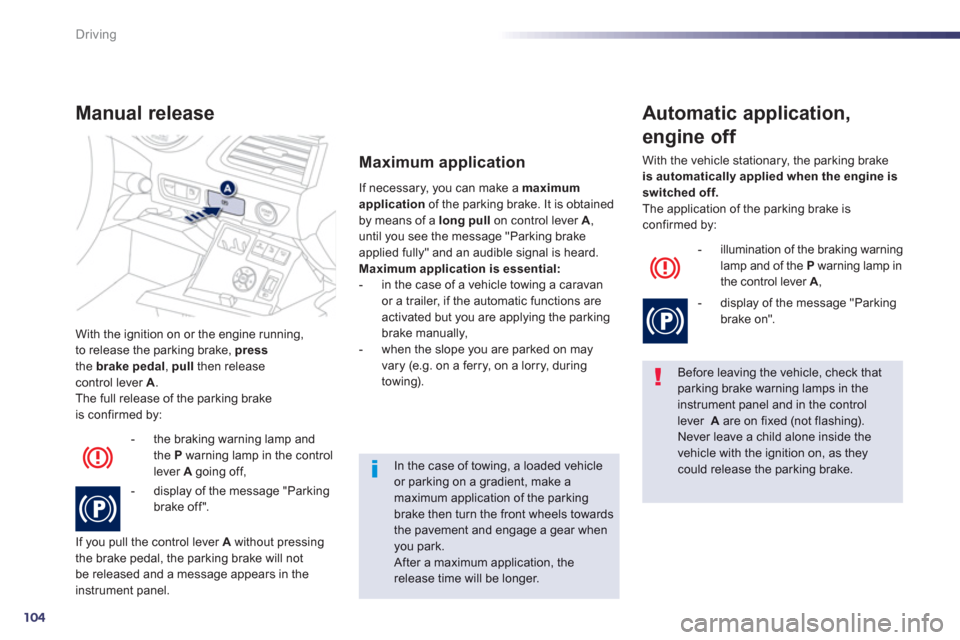
104
Driving
With the ignition on or the engine running,
to release the parking brake, pressthe brakepedal
, pullthen releasecontrol lever A
.
The full release of the parking brake
is confirmed by:
Manual release
- the braking warning lamp and
the P warning lamp in the controllever A
going off,
- displa
y of the message "Parking brake off".
I
f you pull the control lever Awithout pressing
the brake pedal, the parking brake will not
be released and a message appears in the
instrument panel. If necessar
y, you can make a maximum
applicationof the parking brake. It is obtained by means of a long pullon control lever A,
until you see the message "Parking brake
applied fully" and an audible signal is heard.Maximum application is essential:
- in the case of a vehicle towing a caravanor a trailer, if the automatic functions are
activated but you are applying the parkingbrake manually,
- when the slope you are parked on mayvary (e.g. on a ferry, on a lorry, during
towing).
Maximum application
Before leaving the vehicle, check that parking brake warning lamps in the instrument panel and in the control lever A
are on fixed (not flashing).
Never leave a child alone inside thevehicle with the ignition on, as they could release the parking brake.
Automatic application,
engine off
- illumination of the braking warning
lamp and of the Pwarning lamp in
the control lever A ,
- displa
y of the message "Parkingbrake on".
With the vehicle stationary, the parking brake is automatically applied when the engine is
switched off. The application of the parking brake is confirmed by:
In the case of towing, a loaded vehicleor parking on a gradient, make amaximum application of the parkingbrake then turn the front wheels towards the pavement and engage a gear whenyou park.
After a maximum application, the release time will be longer.
Page 107 of 340
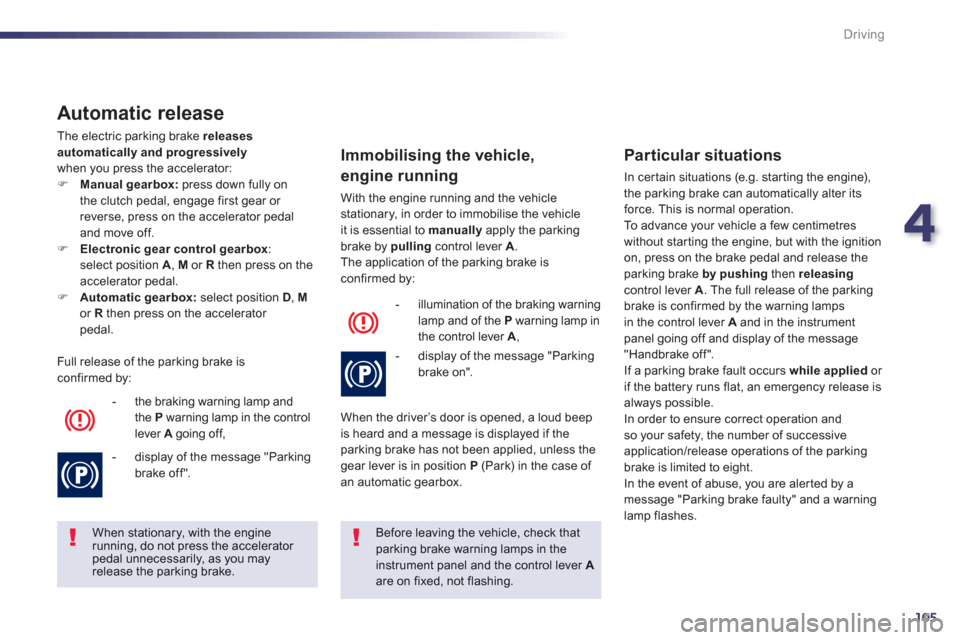
4
105
Driving
Automatic release
The electric parking brake releases automatically and progressively
when you press the accelerator:FManual gearbox:
press down fully on
the clutch pedal, engage first gear or reverse, press on the accelerator pedaland move off.FElectronic gear control gearbox : select position A
, M
or Rthen press on theaccelerator pedal. F Automatic gearbox:select position D , Mor Rthen press on the accelerator pedal.
Full release o
f the parking brake is confirmed by:
- the braking warning lamp and
th
e P warning lamp in the control
lever Agoing off, A
- display of the message "Parking brake off".
When stationary, with the engine running, do not press the accelerator pedal unnecessarily, as you may release the parking brake.
Before leaving the vehicle, check thatparking brake warning lamps in theinstrument panel and the control lever Aare on fixed, not flashing.
Immobilising the vehicle,
engine running
With the engine running and the vehicle
stationary, in order to immobilise the vehicle it is essential to manually
apply the parking
brake by pulling
control lever A.
The application of the parking brake is confirmed by:
- illumination o
f the braking warning
lamp and of the Pwarning lamp in
the control lever A ,
- displa
y of the message "Parkingbrake on".
When the driver’s door is opened, a loud beep
is heard and a message is displayed if theparking brake has not been applied, unless thegear lever is in position P (Park) in the case of an automatic gearbox.
Particular situations
In cer tain situations (e.g. star ting the engine),
the parking brake can automatically alter itsforce. This is normal operation.
To advance your vehicle a few centimetres
without star ting the engine, but with the ignition on, press on the brake pedal and release the
parking brake by pushing then releasingcontrol lever A
. The full release of the parking
brake is confirmed by the warning lamps in the control lever Aand in the instrument
panel going off and display of the message
"Handbrake off".
If a parking brake fault occurs while appliedor
if the battery runs flat, an emergency release is
always possible.
In order to ensure correct operation and
so your safety, the number of successive
application/release operations of the parking brake is limited to eight.
In the event of abuse, you are aler ted by a
message "Parking brake faulty" and a warning
lamp flashes.
Page 108 of 340
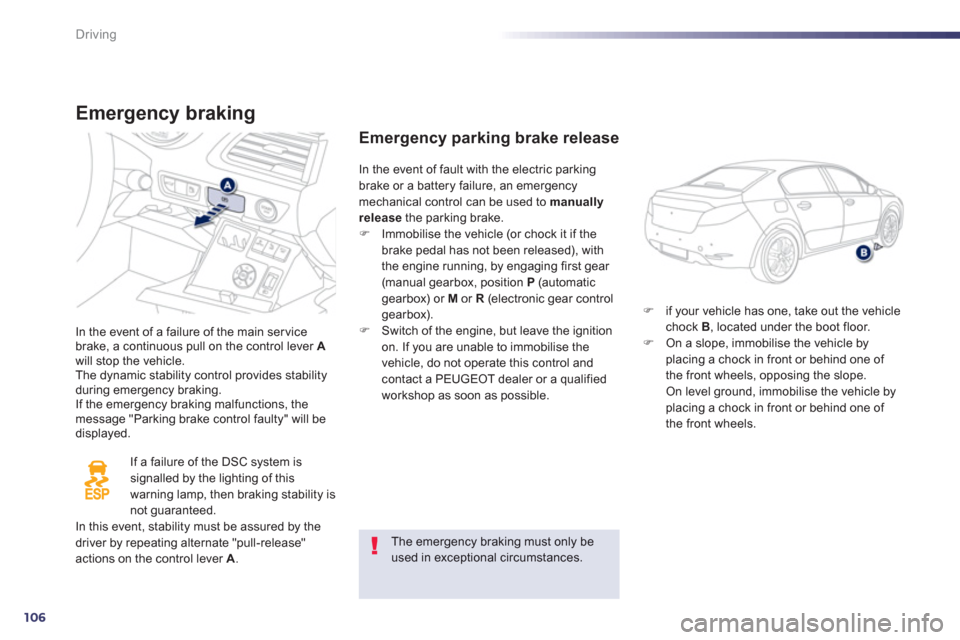
106
Driving
Emergency braking
In the event of a failure of the main servicebrake, a continuous pull on the control lever Awill stop the vehicle.The dynamic stability control provides stability during emergency braking.
If the emergency braking malfunctions, themessage "Parking brake control faulty" will be displayed.
If a failure of the DSC s
ystem is
signalled by the lighting of this
warning lamp, then braking stability is
not guaranteed.In this event, stability must be assured by thedriver by repeating alternate "pull-release" actions on the control lever A.
Emergency parking brake release
Fif your vehicle has one, take out the vehicle chock B , located under the boot floor. FOn a slope, immobilise the vehicle byplacing a chock in front or behind one of
the front wheels, opposing the slope. On level ground, immobilise the vehicle byplacing a chock in front or behind one of
the front wheels.
In the event o
f fault with the electric parkingbrake or a battery failure, an emergencymechanical control can be used to manually
releasethe parking brake.F Immobilise the vehicle (or chock it if the
brake pedal has not been released), with
the engine running, by engaging first gear (manual gearbox, position P(automatic gearbox) or M or R(electronic gear control
gearbox). F Switch of the engine, but leave the ignition on. If you are unable to immobilise the
vehicle, do not operate this control and
contact a PEUGEOT dealer or a qualified
workshop as soon as possible.
The emergency braking must only be used in exceptional circumstances.
Page 109 of 340
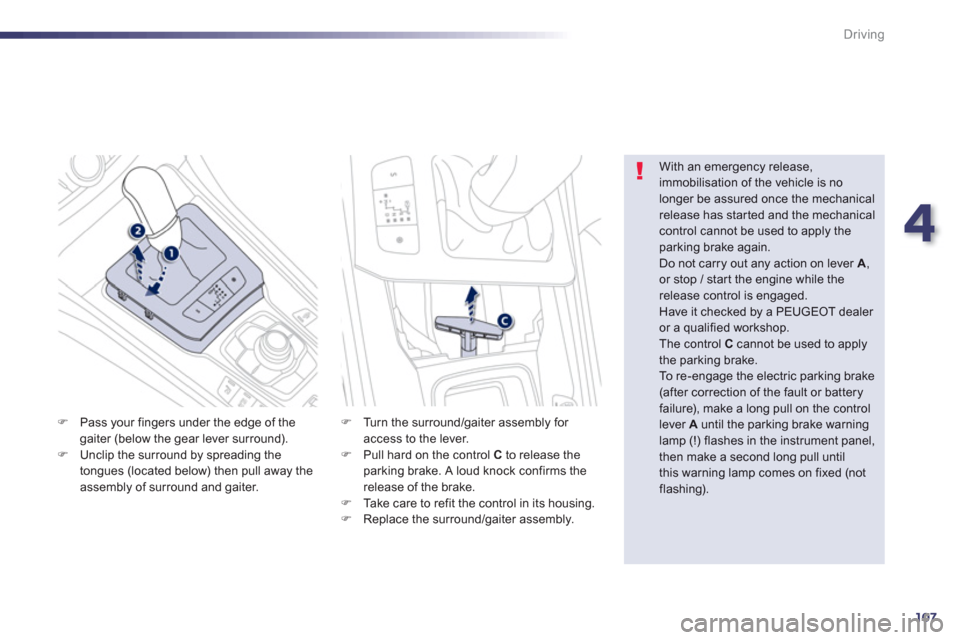
4
107
Driving
F Pass your fingers under the edge of the
gaiter (below the gear lever surround).F
Unclip the surround by spreading the
tongues (located below) then pull away theassembly of surround and gaiter.
With an emergency release,immobilisation of the vehicle is nolonger be assured once the mechanical release has started and the mechanical
control cannot be used to apply theparking brake again.
Do not carry out any action on lever A , or stop / star t the engine while therelease control is engaged.
Have it checked by a PEUGEOT dealer or a qualified workshop.
The control C
cannot be used to apply the parking brake.
To r e - e ngage the electric parking brake(after correction of the fault or batteryfailure), make a long pull on the controllever A
until the parking brake warninglamp (!) flashes in the instrument panel, then make a second long pull until this warning lamp comes on fixed (not flashing).
FTurn the surround/gaiter assembly for
access to the lever.FPull hard on the control C
to release theparking brake. A loud knock confirms the release of the brake. FTake care to refit the control in its housing.
FReplace the surround/gaiter assembly.
Page 111 of 340
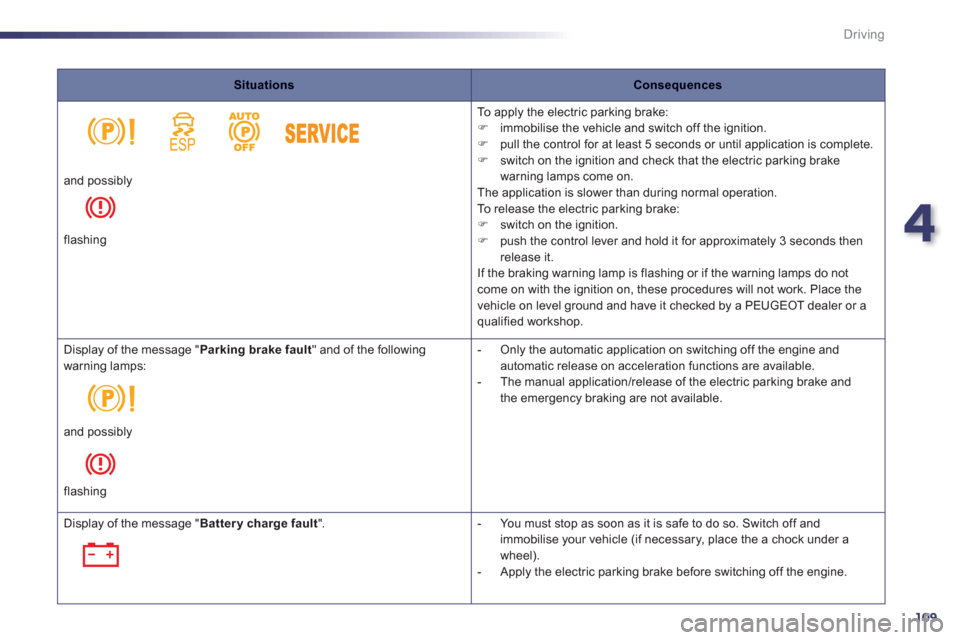
4
109
Driving
SituationsConsequences
To apply the electric parking brake: F immobilise the vehicle and switch off the ignition. F
pull the control for at least 5 seconds or until application is complete.F
switch on the ignition and check that the electric parking brake
warning lamps come on.
The application is slower than during normal operation.
To release the electric parking brake:
F
switch on the ignition. F
push the control lever and hold it for approximately 3 seconds then
release it.
If the braking warning lamp is flashing or if the warning lamps do not come on with the ignition on, these procedures will not work. Place the
vehicle on level ground and have it checked by a PEUGEOT dealer or aqualified workshop. and possibl
y
flashing
Display of the message "Parking brake fault" and of the following warning lamps:
- Only the automatic application on switching off the engine andautomatic release on acceleration functions are available.
- The manual application/release of the electric parking brake and
the emergency braking are not available.
and possibly
flashin
g
Display of the message "Battery charge fault".
- You must stop as soon as it is safe to do so. Switch off and
immobilise
your vehicle (if necessary, place the a chock under a
wheel).
- Apply the electric parking brake before switching off the engine.
Page 113 of 340
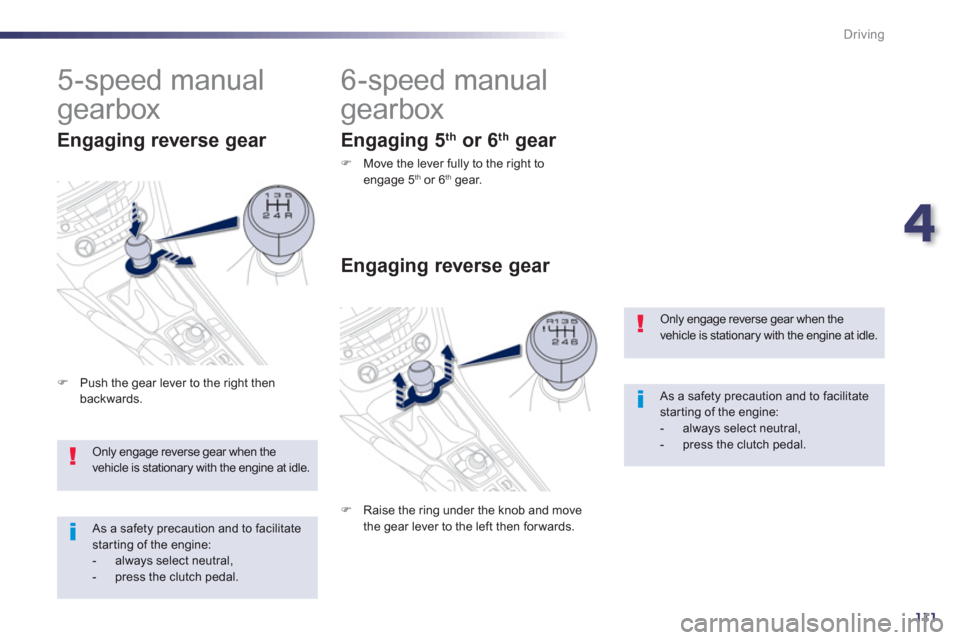
4
111
Driving
Only engage reverse gear when thevehicle is stationary with the engine at idle.
As a safety precaution and to facilitatestarting of the engine:- always select neutral, - press the clutch pedal.
6-speed manual
gearbox
Engaging 5th or 6thgear
FMove the lever fully to the right to engage 5 th
or 6th
gear.
Only engage reverse gear when the vehicle is stationary with the engine at idle.
As a safety precaution and to facilitate star ting of the engine:
- always select neutral,
- press the clutch pedal.
5-speed manual
gearbox
F Push the gear lever to the right then backwards.
Engaging reverse gear
En
gaging reverse gear
FRaise the ring under the knob and move
the gear lever to the left then forwards.
Page 114 of 340
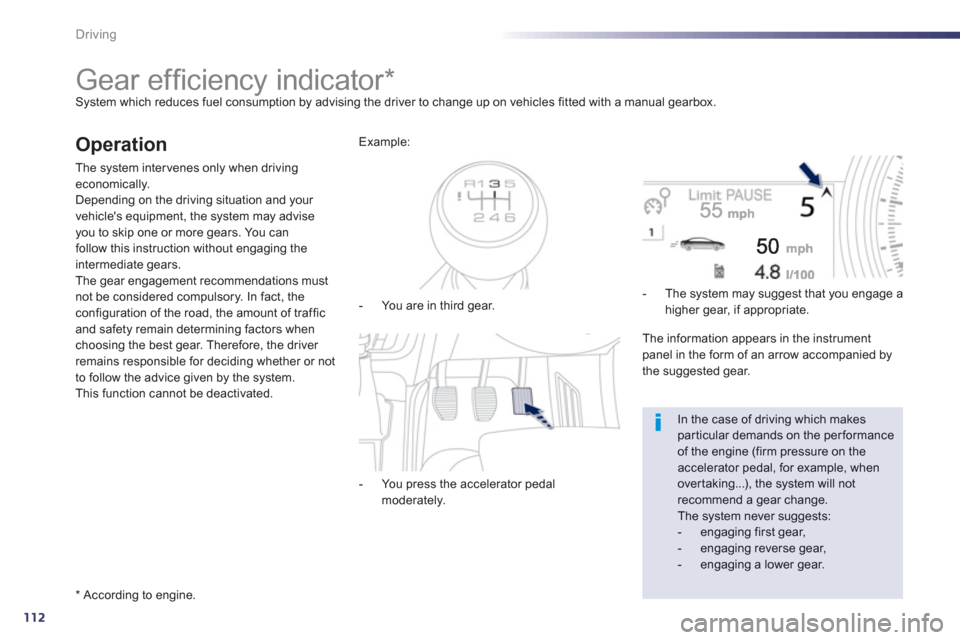
112
Driving
Gear effi ciency indicator * System which reduces fuel consumption by advising the driver to change up on vehicles fitted with a manual gearbox.
Operation
The system inter venes only when driving economically.
Depending on the driving situation and your
vehicle's equipment, the system may advise you to skip one or more gears. You can follow this instruction without engaging the intermediate gears.The gear engagement recommendations mustnot be considered compulsory. In fact, the configuration of the road, the amount of trafficand safety remain determining factors whenchoosing the best gear. Therefore, the driver remains responsible for deciding whether or not
to follow the advice given by the system.
This function cannot be deactivated.
*
Accordin
g to engine.
- You are in third
gear.
Exam
ple:
- You press the accelerator pedal
mo
derately.
- The s
ystem may suggest that you engage a higher gear, if appropriate.
The information appears in the instrument
panel in the form of an arrow accompanied bythe suggested gear.
In the case of driving which makespar ticular demands on the performance of the engine (firm pressure on theaccelerator pedal, for example, whenover taking...), the system will notrecommend a gear change. The system never suggests:
- engaging first gear,
- engaging reverse gear,
- engaging a lower gear.
Page 115 of 340
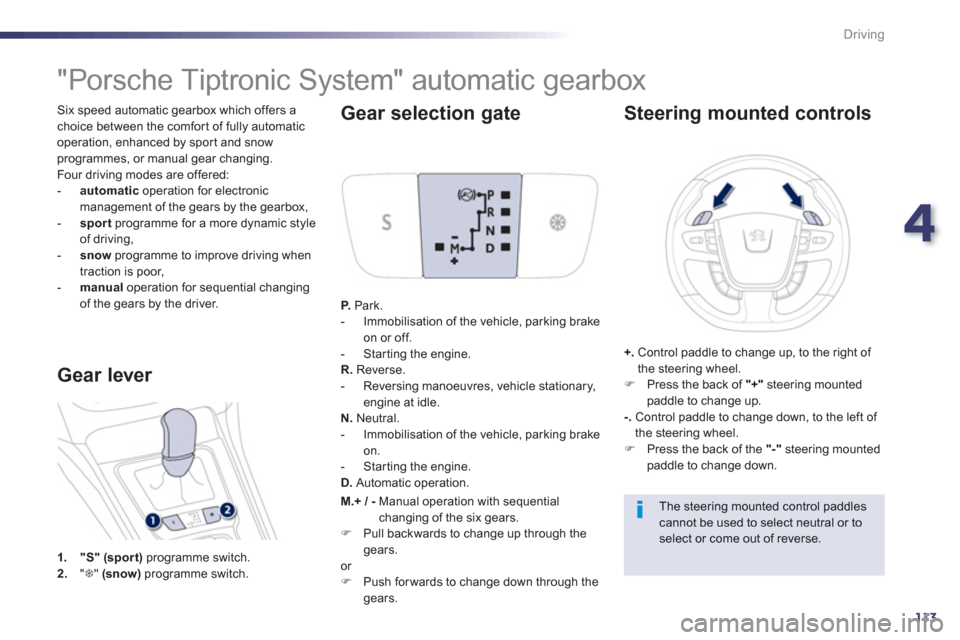
4
113
Driving
Six speed automatic gearbox which offers a choice between the comfor t of fully automatic
operation, enhanced by spor t and snow
programmes, or manual gear changing.
Four driving modes are offered:-automatic
operation for electronic management of the gears by the gearbox,
-
sport
programme for a more dynamic style
of driving,
- snowprogramme to improve driving when
traction is poor,
- manua
loperation for sequential changing
of the gears by the driver.
"Porsche Tiptronic System" automatic gearbox
1."S"(sport)
programme switch. 2."T
" (snow)programme switch.
Gear lever Gear selection
gate
P.Park.
- Immobilisation of the vehicle, parking brakeon or off.
- Starting the engine.
R. Reverse.
- Reversing manoeuvres, vehicle stationary, engine at idle.N.Neutral.
- Immobilisation of the vehicle, parking brakeon.
- Starting the engine.D.
Automatic operation.
Steering mounted controls
+. Control paddle to change up, to the right of
the steering wheel.F Press the back of "+"steering mountedpaddle to change up.-.
Control paddle to change down, to the left of
the steering wheel. F Press the back of the "-"
steering mounted paddle to change down.
The steering mounted control paddles cannot be used to select neutral or to
select or come out of reverse.
M.+ / - Manual operation with sequential changing of the six gears.
FPull backwards to change up through thegears. or FPush for wards to change down through the gears.